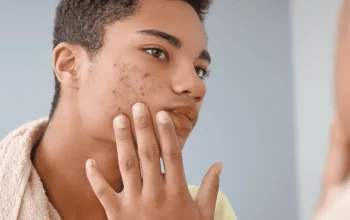Hormonal acne occurs as a result of hormonal fluctuations that lead to an excess production of sebum that clogs pores and causes inflammation, often during puberty, pregnancy and menstruation cycles. Hormonal acne may also appear during perimenopause or menopause when estrogen levels decline significantly, although these cases are rarer than others.
A healthy skincare routine and hormone-regulating medications can be effective tools in managing hormonal acne. Beginning treatment early is key in order to avoid post-inflammatory hyperpigmentation and deep cysts from occurring later on.
Estrogen
Estrogen is a natural sex hormone that regulates oil production and minimizes clogged pores. Additionally, estrogen plays a part in menstruation cycles, pregnancies and menopausals – yet too much estrogen increases your risk for acne breakouts.
Acne breakouts caused by hormonal fluctuations can often be treated effectively. A birth control pill containing estrogen and progesterone, commonly referred to as ECP, may help block androgens such as testosterone from your system and therefore help prevent breakouts.
Additionally, 17ss-estradiol can help protect against breakouts by blocking androgen receptors and decreasing sebum production. Furthermore, combined oral contraceptives with progestins may inhibit 5a-reductase enzyme, responsible for turning testosterone into sebum production – this can help unclog pores and decrease inflammatory lesions.
Testosterone
Testosterone plays an important role in acne by stimulating your body to produce sebum, an oil produced naturally by skin glands that can block hair follicles. This leads to whiteheads, blackheads and various other forms of lesions such as pustules (pinkish-red bumps filled with pus), cysts and nodules.
Testosterone is often thought of as being exclusively male hormone, but women also produce small amounts of this and other steroid hormones (androgens) like testosterone for themselves and to maintain strong bones, muscle mass, healthy libidos and regulate menstruation cycles.
Hormonal acne remains poorly understood, yet researchers believe elevated testosterone and other androgens could contribute to overproduction of sebum, leading to inflamed sebaceous glands and leading to clogged pores which trap dead skin cells, dirt and bacteria which lead to breakouts of whiteheads, blackheads or pustules on skin-colored spots or reddish or pinkish bumps known as pustules. Implementing a gentle skincare routine using noncomedogenic makeup products could reduce risk.
Progesterone
Progesterone, produced in your ovaries and placenta during gestation, helps prepare the uterus for implantation (when fertilized eggs attach themselves to its lining) and promote a healthy pregnancy. It thickens uterine lining while simultaneously prepping breasts to nurse.
Progesterone is a steroid hormone and part of the estrogen family of reproductive hormones. Like estrogen, progesterone increases oil production from your skin (sebum). Because testosterone and other androgens (male hormones that promote pubic hair growth and give boys manly voices while making girls develop breasts and curves) also increase sebum production, these two can increase acne as well.
Progesterone, a natural steroid found in plants like yams and black cohosh, can also be purchased without a valid doctor’s prescription in cream form. Unfortunately, however, such non-pure progesterone may not work as effectively and could pose risks to both you and your baby’s wellbeing. Using unregulated progesterone could not only put both parties at risk; it may even pose health hazards of its own.
Other Hormones
Acne is often caused by hormonal fluctuations stimulating oil glands to produce more sebum, leading to blocked pores and encouraging bacteria growth that results in inflammation that forms pimples that then grow larger over time. Women are especially prone to hormonal acne as fluctuations in estrogen, progesterone and testosterone levels occur during puberty, menstruation cycles, pregnancy and menopause – also contributing factors include weight gain as well as darkened armpits/back/neck (acanthosis nigricans) or Cushing’s syndrome symptoms.
Though teenage acne days may have passed, many adults continue to struggle with breakouts and hormone-related issues that impact appearance and self-esteem. Gaining an understanding of how hormonal fluctuations impact acne is key in developing an effective skincare routine and diet that prevents outbreaks; medication that counteracts androgen effects on sebum production while decreasing inflammation such as oral retinoids, spironolactone (a blood pressure medication) or flutamide (an effective prostate cancer drug) could be effective treatments as well.








